
Dance improvisation in Altana Galerie
Cynthia Gonzalez and Teresa Hackel [dance]
Johnny Gonzalez [piano]
Altana Galerie Dresden, July 2009

Görges-Bau of the Technical University Dresden harbors an atrium surrounded by galleries. The atrium is used for the demonstration of large machinery while the galleries accommodate exhibits of smaller devices and work of art. Since April, Altana Galerie presented "Intellible Prozesse", an art exhibition by Jürgen Blum-Kwiatkowski and his Free Academy of Art. The performance marked the closing of the exhibition.
To catch the dancers and the pianist on one photo was not easy. On the left you see Johnny Gonzalez playing in a gallery on one side of the atrium while watching the moves of the dancers who perform in a gallery across the atrium. Johnny deliberately restrained the rhythmical drive his jazz/Latin fusion, known to his fans in Dresden from performances in Göthe Institute and elsewhere. Instead he presented two emotive preludes in rubato with dramatic arpeggios, romantic phrases and repetitive chromatic riffs in a minimalistic tradition. While plying he constantly watched the dancers, giving them enough freedom for their improvisation. When the dance asked for silence he stopped playing.
The final movement of his second piece was remarkable. Minimalistic structures and slightly dissonant chords alternated and merged. A tango melody popped up only to be displaced by a crisp chromatic pattern played on the rightmost keys of the piano. The piece resolved to a set of quartal chords reminiscent of impressionism. Johnny played them repeatedly the pedal pressed, enriching the sound by the resonation of strings of the keys he did not hit.
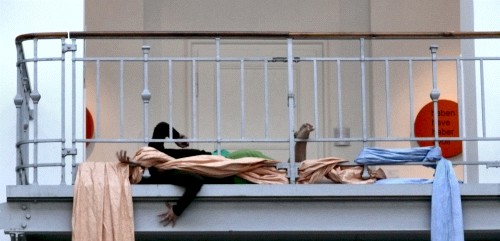
The dancers started their contact improvi-sation hidden behind stripes of pink and blue fabric fixed to the banister. If I caught the title mentioned in the introduction by curator Reinhild Tetzlaff (there was no public announcement or program leaflet), the piece was inspired by the legend of Phoenix rising from its ashes.

Supporting each other, the dancers elevated their bodies while remaining in close contact.
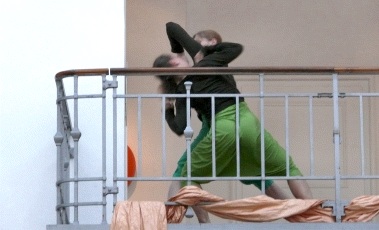

Later they separated and moved to other galleries. There they chased each other, staged a fight, played games. Banisters and the free space apparently attracted them. Cynthia liked to stick her legs through the bars. Once she locked them outside the banister in a lotus-like position, another time Teresa touched her feet in a free space, for which she had to lean far over the banister.
At the end they came together again, with gestures that one might read as regret and forgiveness. They raised their arms, bent over the banister and stared into free space as firebirds prepared to take off.
It was getting dark and the distance to the dancers was large. I made my own story in a Norway Today style: The two came together after all the hassle and pain but did not find relief. The fight robbed them of the ability to live out what they struggled for. I hear words borrowed from another Cynthia's piece:
"Jump!"
"Only when you jump with me."
Below you see part of the atrium and the lowest level of galleries (compare the hanging stripes of fabric with the picture at the top of the page). The photographies were taken from a place next to Johnny Gonzalez' piano (zoomed with Leica optics). Notice Prof. Blum-Kwiatkowski watching the dance from a close distance.
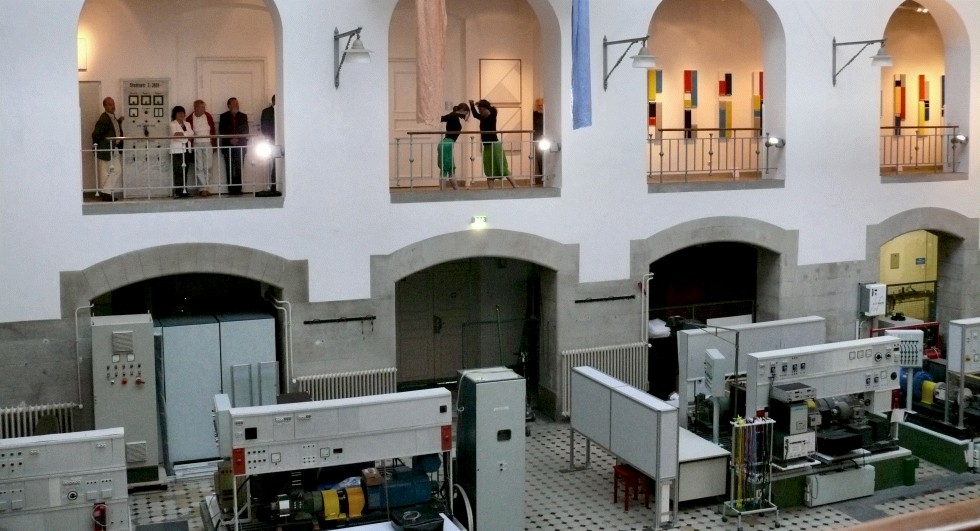
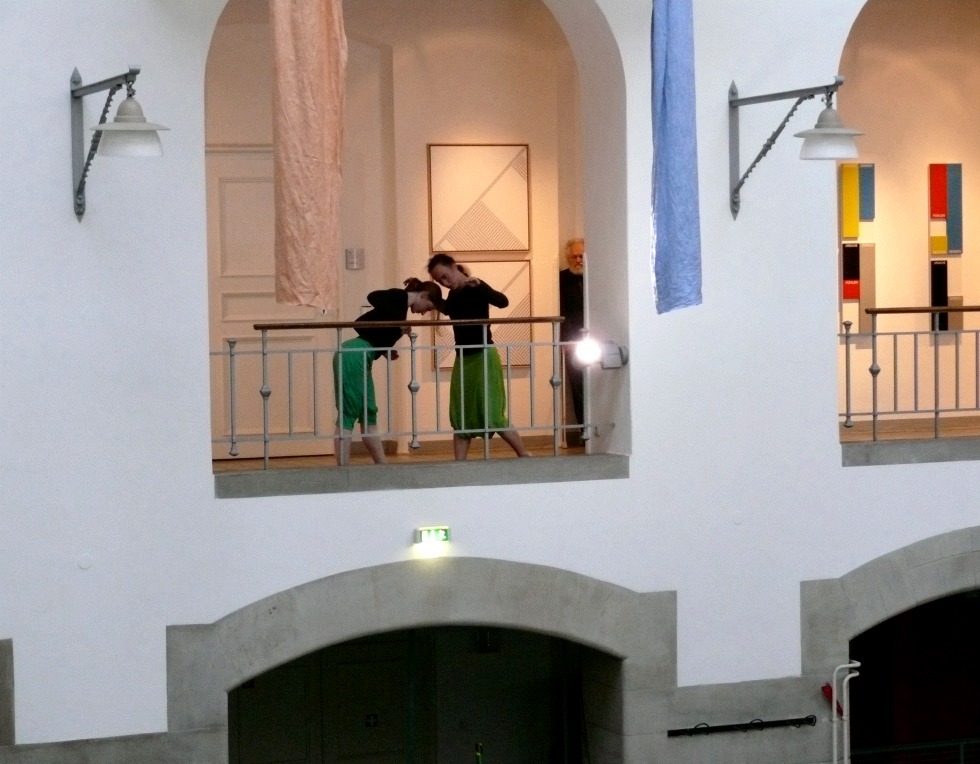
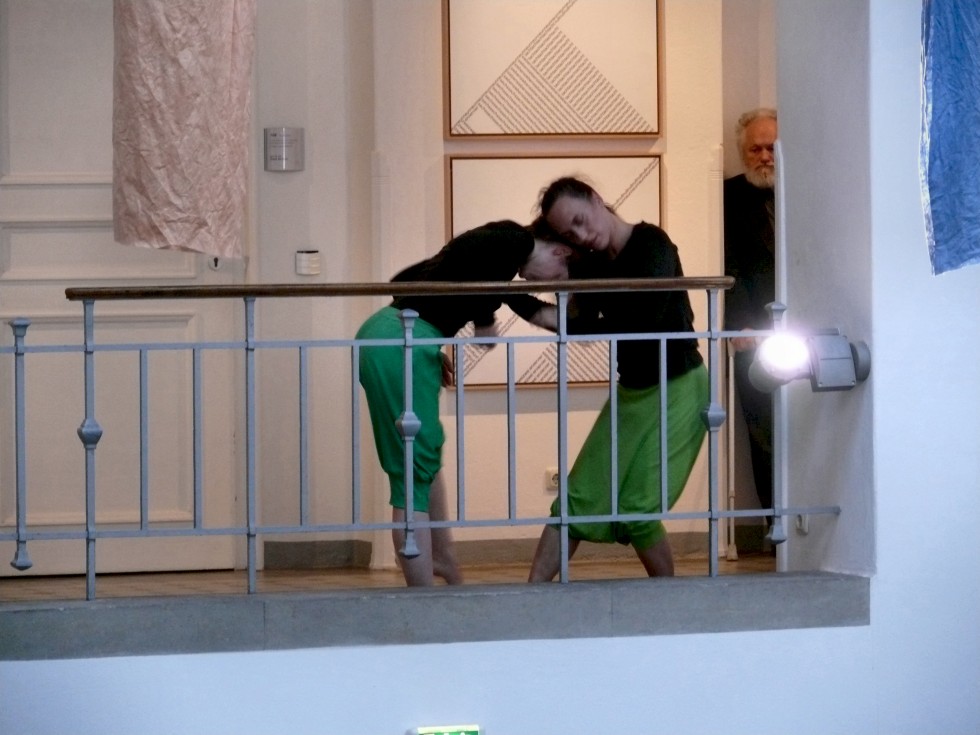
The performance took about 30 minutes. After it finished, people did not seem to want to leave. Johnny therefore offered to play two more pieces as an encore.
The first was one of his compositions in bebop style. The eight-bar motif was merely hinted, followed by a breathtaking improvisation. Immaculately accurate left-hand kept the puls for stunningly fast riffs of the right hand. In the middle of the piece Johnny's left hand switched to boogie while the right hand abandoned the eight-bar scheme, running its own patterns with and against the rhythm. Until after several rounds both hands met precisely at the beginning of the phrase again. This is one of the satisfaction of good jazz: get lost and enjoy coming back, finding back to the tonic exactly at the right moment. Not all kinds of jazz give you this comfort: In swing you don't get lost and in free jazz you don't find back. Actually there is no back. But it is another story. In the meantime Johnny's left hand abandoned boogie and began imitating ground bass while the right hand continued inventing intelligent stories, until both joined in a marvelous syncopation in a rare moment of parallel movement. I knew the piece since a while but the improvisation this night was the best.
Petr Karlovsky